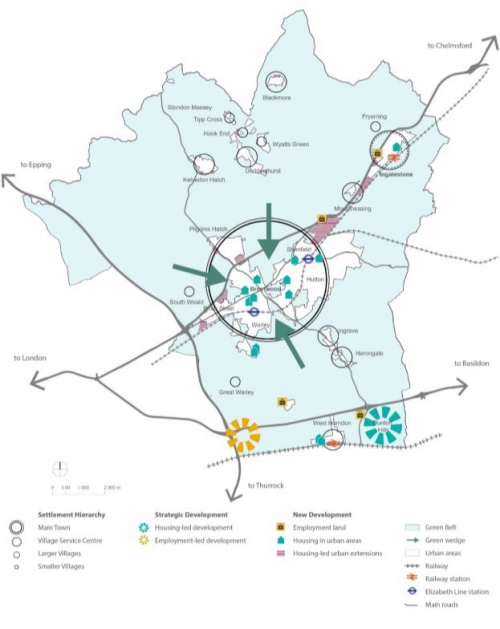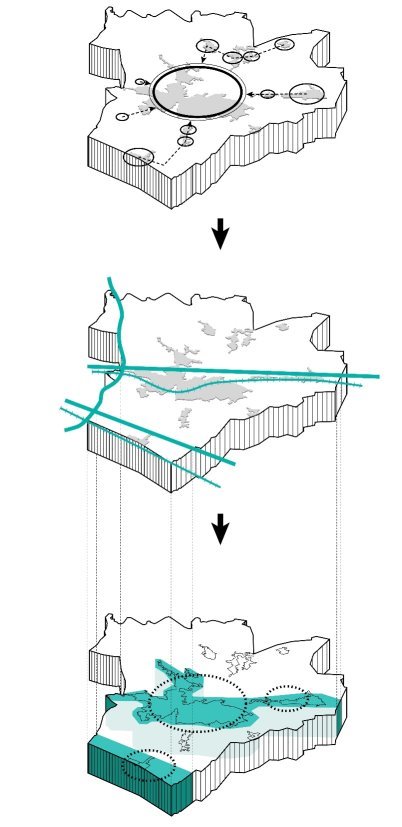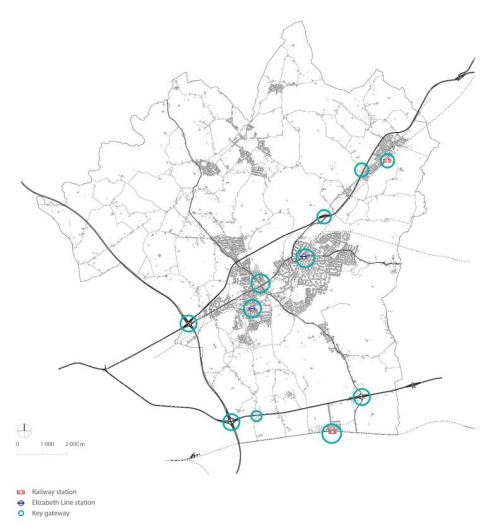Brentwood Local Plan 2016 - 2033 (Pre-Submission, Regulation 19)
3. Spatial Strategy - Vision and Strategic Objectives
(10) Vision
|
Bearing testimony to its market town origins, Brentwood Borough will continue to thrive as a place of commerce and enterprise, strengthened by our proposals to protect existing employment sites, and enhance and develop new sites of economic opportunity, with good connectivity to wider markets. Brentwood will continue to be a desirable, liveable place to live and visit and encourage healthy active lifestyles. It will provide the 'best of both worlds' where the benefits of urban living can be enjoyed, the bustling high street can continue to thrive and provide opportunities for entertainment and culture, where the surrounding countryside and numerous Country Parks will continue to provide havens to wildlife, as well as beautiful and historic locations to be explored through active recreational pursuits. We are a 'Borough of Villages' and we will continue to maintain our village character, ensuring development respects and enhances these environmental qualities that give Brentwood its distinctive character. We will encourage this through landscape-led development, where new development responds to a 'design and build with nature' approach, firmly embedding high quality green infrastructure through the public realm to create a seamless transition to our surrounding countryside. |
(6) Spatial Strategy Driving Factors
3.1 Underpinning this vision are three overarching driving factors:
- Meeting the Council's priorities for the borough, as set out in the Corporate Plan – 'A Vision for Brentwood';
- Challenges and opportunities that inform how the borough should better manage development and change; and
- Meeting the borough's housing needs.
3.2 The overall strategy applies to all development in the borough. The Plan's vision, strategic objectives and planning policies are all underpinned by the spatial strategy. Spatial Policies within this chapter set out the aims of the strategy. Strategic and Development Management Polices that follow provide the framework for its delivery.
Corporate Plan Priorities
3.3 Underpinning this vision is the desire to address priorities set out in the Council's Corporate Plan - 'A Vision for Brentwood', under the themes: Environment and Housing Management, Community and Health, Economic Development, Planning & Licensing, and Transformation. The Local Plan will be one of the ways in which the aims and objectives of the Corporate Plan are achieved.
3.4 Supporting the delivery of this vision are a series of strategic objectives and spatial development principles outlining how growth and change is to be managed across the borough through the Plan period. The Spatial Strategy described in this chapter provides the framework for managing change and shaping how the area develops in future.
3.5 Principally, the spatial strategy sets out the level and location of development and growth and the key areas of change up to 2033, highlights the borough's built and natural assets to be safeguarded and enhanced.
Spatial Challenges and Opportunities
(2) 3.6 The spatial strategy is informed by the following challenges and opportunities:
- Brentwood's principle character and settlement pattern as a 'Borough of Villages' are retained;
- Limited availability of previously developed land (Brownfield), due to Brentwood's largely rural setting within the Green belt, which makes up 89% of the borough area;
- Areas of landscape and environmental sensitivity, especially to the south of Brentwood and Shenfield;
- Growth options that meet sustainability criteria for accessibility to facilities and travel modes, and ensuring minimal impact on key environmental designations;
- Integrated and accessible transit routes that form key connections to London and the wider economic opportunities of South Essex; and
- Capacity of existing infrastructure and the need for new facilities.
(2) Housing Need
3.7 Provision of sufficient housing is critical to meet the needs of a growing population and for the effective functioning of local economies.
3.8 The Council is committed to planning positively to increase the supply of new homes to meet the needs of the area, as well as providing adequate employment land to boost the supply of jobs in the area, ensuring a healthy local economy.
3.9 To meet the requirements of national policy, local planning authorities are expected to identify their local housing need and ensure that their Local Plans meet this need in full for market and affordable housing; the spatial strategy sets out the Council's provision to meet this need in full, proposing to make additional land allocations above minimum need to provide additional flexibility in the supply and delivery of sites.
(1) Spatial Strategy Overarching Aims
3.10 Driven by Brentwood's Borough of Villages character, our spatial strategy focuses on three main driving forces:
(12) Transit-orientated Growth
(1) 3.11 Brentwood has two key transit corridors running through the borough: the 'Central Brentwood Growth Corridor', with the A12, the Great Eastern Main Line to London Liverpool Street Station, and the Elizabeth Line; and the 'Southern Brentwood Growth Corridor', with the A127 and the London, Tilbury and Southend Railway to London Fenchurch Street Station. These form key connectivity axes. Focusing growth along these axes will ensure that future development is sustainable, maximising the benefits of transport infrastructure. While some investment to improve the transport network will be inevitable, this growth strategy ensures economies of scale are reached, with the critical mass of development making it more viable for such investment to occur.
Developing Naturally and Sustainably
3.12 Given Brentwood's village feel and countryside setting, development must be mindful of the ecological sensitivity and disruption to ecosystem services. For this reason, development should take a 'design and build with nature' approach. This will not only plan for resilient and smart infrastructure but also create living environments conducive to human health.
Healthy Communities
3.13 Growing from a market town to the diverse economy it is today, future development should capitalise on this evolution to ensure a diverse balance of employment opportunities for all alongside vibrant hubs of economic and social-cultural activity to provide attractive, connected, walkable, lively and stimulating destinations with the necessary facilities and services required to sustain healthy and active communities.
3.14 These goals are supported by four strategic objectives and respective policies, as illustrated in Figure 1.1.
(7) Strategic Objectives
3.15 This section defines our four strategic objectives and how the supporting policies align to help deliver these.
(2) 3.16 SO1: Manage Growth Sustainably, by directing development to the most sustainable locations, ensuring that the characteristics and patterns of our different settlements are protected and enhanced to provide a strong emphasis on 'sense of place' to be enjoyed by people living, working and visiting Brentwood.
(2) 3.17 SO2: Deliver a Healthy and Resilient Built Environment, one where our design creates spaces that encourage social interaction and healthy active lifestyles; mitigates, reduces impact or adapts to conditions of a changing climate through smart infrastructure; creates public realm and homes where both the internal and external spaces are conducive to human health.
(4) 3.18 SO3: Deliver Sustainable Communities with Diverse Economic & Social-cultural Opportunities for all, opportunities which flexibly respond to the changing economic climate and employment sector trends making citizens feel economically empowered to enjoy and benefit from the necessary community/social infrastructure that sustains inclusive, informed, vibrant, active and cohesive communities.
(3) 3.19 SO4: Deliver Beautiful, Biodiverse, Clean and a Functional Natural Environment, where our natural heritage is protected, and ecosystem services are restored, enhanced and integrated back into the built environment through multi-functional green and blue infrastructure.
3.20 The policies are split into two types;
- Spatial policies which provide the overarching strategic guidance to steer development opportunities across the borough. Most of these policies relate to delivering Strategic Objective SO1; and
- Development management policies which provide more details on a number of thematic topics.
(7) Growth Areas
(2) 3.21 Two key growth areas have been identified, considering our overarching aim to deliver sustainable development in transit corridors, through a process of sequential analysis and review of sites:
- In the Central Brentwood Growth Corridor, we will maximise every opportunity to bring forward brownfield land for development, where appropriate, in Brentwood and Shenfield. This will take account of the arrival of the Elizabeth Line, and reflect our commitment to deliver brownfield development, in consistency with the NPPF (2018). However, brownfield land is limited; and given the opportunity for new development to invest in infrastructure and facilities, we will grow the wider Brentwood Urban Area by providing urban extensions in places where development can be contained, and where Green Belt harm is minimized. This is in response to local housing needs and limited brownfield capacity, providing exceptional circumstances to consider limited use of Green Belt. In addition, opportunities to grow Ingatestone Village will be taken where contained sites can deliver an urban extension to the south, providing new housing and supporting employment.
- In the South Brentwood Growth Corridor, we will deliver a strategic allocation at Dunton Hills Garden Village, providing a new mixed-use, self-sustaining community in the south-east of the borough. A strategic allocation at M25 junction 29 (Brentwood Enterprise Park) will provide for most of the new employment land needed, bringing forward a modern business park village in the south-west of the borough with excellent access to the M25. This will also act as a focus for a wider M25/A127 employment cluster considering existing employment uses in the area. Brownfield opportunities will be taken to effectively meet local needs, such as a residential-led, mixed-use redevelopment of existing industrial land in West Horndon, creating a new village centre with supporting services and facilities close to the village rail station. Developing here provides an opportunity to address conflicts arising from heavy freight traffic passing through the village. Residential-led development in the area will help strengthen the village centre and improve service provision. Significant improvements to infrastructure and services will be required to support growth within the Corridor.
- Development in areas outside these growth areas corridors will be limited, to retain the local character. Brownfield opportunities will be encouraged where appropriate schemes help meet local needs and ensure that our villages remain thriving communities, in line with policies in this Plan. Where appropriate, this includes the redevelopment of previously developed sites in Green Belt and infill while improving links to nearby villages.
(1) Key Diagram
(1) 3.22 The Key Diagram shows the main aspects of the spatial strategy set within the broader local context. This also includes some key aims of other policies in the Plan.

(2) Figure 3.1: Key Diagram

Spatial Development Principles
(1) Using Land Sequentially
(5) 3.23 The spatial strategy considers each location in terms of a sequential land use test. Development proposals in the borough will follow the following principles:
- Urban areas – Prioritise brownfield sites wherever suitable and make efficient use of land;
- Brownfield Green Belt – Use of previously developed land in the Green Belt where in accordance with policies in the Plan;
- Strategic sites – Use opportunities created by larger housing development to deliver new homes and supporting services and infrastructure;
- Urban extensions – Deliver new homes in areas close to existing transport intrastate and local facilities; and
- Windfall – An allowance is made for small scale development that will come forward in future not currently identified, in line with proposed policies to effectively and efficiently use land to meet local needs.
Strategic Sites
(1) 3.24 Strategic sites have been identified separately to other development allocations in order to deliver the significant amount of growth to meet local needs, specifically new homes and new jobs. These are displayed on the Key Diagram and set out in site specific policies in Chapter 9. Furthermore, Chapter 9 provides background information on the selection process of Dunton Hills Garden Village as a strategic allocation capable of meeting the majority of Brentwood's housing need, within the Plan period.
(2) Borough Gateways
3.25 Development proposals in the vicinity of key gateways into Brentwood Borough, as set out in Figure 3.3, will contribute to enhancing a positive impression of the borough. Development should help to create a distinctive and clear entry into Brentwood. Development proposals need to reflect an understanding of the borough's character in line with the spatial strategy and enhance the local area.
3.26 Gateways include, but are not limited to, transport interchanges such as highway junctions and stations. Development should recognise the importance of creating a positive impression for those passing by the site as well as those entering it. These locations, when in urban areas, offer an opportunity for higher densities and employment locations. In addition, public art and public realm improvements can be considered.

